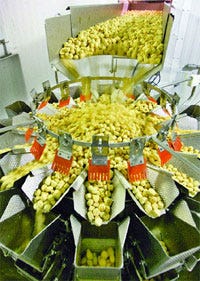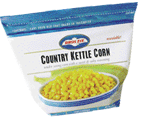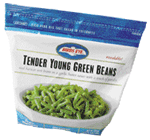March 11, 2015
At Birds Eye Foods, Rochester, NY, product quality and package integrity go hand in hand as top priorities. Considered the nation's largest processor of frozen vegetables and more, the $1-billion national food company produces and markets a variety of vegetable product lines under its flagship Birds Eye® brand, as well as private-label and foodservice products in 30 facilities located throughout the U.S. and Mexico.
The company's 70,000-sq-ft facility in Montezuma, GA, processes and packages an amazing 1,500 stockkeeping units, including fried onion rings, breaded hush puppies, and squash and okra, as well as a variety of other frozen vegetables, frozen vegetable blends and chopped, frozen vegetables under the Birds Eye and McKenzie's labels. The vegetables are packed into retail-sized bags from 10 oz to 2 lb and in bulk, lined shipping containers that hold 20 to 30 lb for distribution to institutional/foodservice customers.
The company recently updated its product-handling conveying equipment at the plant in Montezuma, with a $.5-million installation of new FastBack® horizontal-motion conveyors from Heat and Control. The move increased production rates by almost 10 percent, reducing downtime and maintenance costs. In addition, noise levels in the plant are now at a quiet but high-performing hum.
No more shake, rattle 'n roll
Earlier, the vegetable plant relied on a more conventional means of transferring the products from its vegetable coating and frying lines to its product weighers. While the previous conveyors had no chains, gears or motors and seemed well suited to operating in cold rooms in which the products were packed, gradually, there were performance and maintenance issues, according to Birds Eye, that created too much downtime on the company's six vegetable-packaging lines.
 Without constant adjustment, the conveyors couldn't run dense products like peas and chopped, cubed potatoes and lighter-weight, lower-bulk-density vegetables, such as onion rings. With the vibratory amplitude set at the maximum, the bulky products conveyed well, providing that the conveyor bed depth didn't exceed 11/2 in. But without reducing the amplitude, fragile products, such as broccoli florets, became difficult to convey. "That created quite a bit of downtime and maintenance," says Birds Eye's technical manager, Travis Simmons.
Without constant adjustment, the conveyors couldn't run dense products like peas and chopped, cubed potatoes and lighter-weight, lower-bulk-density vegetables, such as onion rings. With the vibratory amplitude set at the maximum, the bulky products conveyed well, providing that the conveyor bed depth didn't exceed 11/2 in. But without reducing the amplitude, fragile products, such as broccoli florets, became difficult to convey. "That created quite a bit of downtime and maintenance," says Birds Eye's technical manager, Travis Simmons.
Birds Eye decided to test the FastBack horizontal-motion conveying system in 1999 and installed one Model 200A conveyor as a test in the most "difficult" location on the production line–the distribution location, which, at a temperature of 18 deg F, is where the majority of problems occurred before. "The cold temperature in this room created issues, and the conveyors in the room must carry the full capacity of the lines," Simmons explains. "Washdowns on the previous equipment were difficult under these cold-temperature circumstances, but we don't have that problem now. FastBack conveyors don't seem to be affected by temperature."
Instead of the bouncing, almost jittery action of the previous conveyors, the FastBack 200A systems use a gentle slow-forward, fast-back conveying motion that reduces product damage, noise, product loss and buildup. Simmons says the smooth, even motion maintains the "mix" in the premixed vegetable blends and has reduced product damage.
Huge drop in maintenance
After experiencing 30 days of trouble-free operation with the new conveyor, Birds Eye ordered three more FastBack systems, and soon added two more. Then in September, 2002, the plant ordered a whopping 23 FastBacks to replace the rest of its existing conveyors, for a total of 29. Heat and Control provided the new conveyors pre-wired and ready to operate, so that Birds Eye was able to install them in a week during the 2002 holidays. With a startup date in the first week of January, 2004, the new FastBack 200A systems ran without a hitch.
"We're not sure exactly just how much the new conveyors have helped cut product damage, but the horizontal-motion FastBack system has the ability to start and stop, which really helps protect vegetables from breakage," says Simmons. "We were experiencing complicated repairs and maintenance on the previous conveyors, where parts would have to be repaired and pans would have to be adjusted. And most of the conveyors operated in a very cold, eighteen-degree-Fahrenheit environment, which didn't help. On the FastBacks, the parts are very easy to troubleshoot. The new conveyors gently glide the products to the weighing stations without jostling them."
Deep, U-shaped, rigid pans now convey higher capacities of product to the weighers, and special screens were added to the inspection-conveyor pans to prevent small product particles from becoming trapped in bag seals. "None of the products–even vegetables with a higher bulk density, such as beans, peas and carrots–posed any transport difficulties for the new conveyors, because of their deeper conveyor pans," Simmons remarks. "The pans run full without a problem."
The results cut maintenance significantly, a key benefit that Birds Eye saw right away, Simmons explains. The FastBacks generate approximately 50-percent higher throughput rates, he adds, which means the packaging lines now run faster. Each conveyor system is engineered to deliver as much as 20,000 lb of product per hour. "We've been adding scales to each line, so that eventually, we'll end up with twelve, so we also decided to completely replace all of the conveyors," Simmons notes. "We didn't want to have any capacity issues later on, in case we want to increase production and expand the operation, add more bagging or weighing equipment or add conveyors."
The length of each conveyor portion varies from 8 to 20 ft. The conveyors glide the product flow downstream without jumps, jitters or jiggles, especially key with breaded or cooked products that have coatings, says Simmons. "The coatings can be lost if you're not careful. The conveyors are also clean-running, because they eliminate product chipping, breakage and buildup."
Collecting, distributing, inspecting
The plant's two vegetable-processing lines cook or bread certain vegetables, such as onion rings and okra. Such products are conveyed directly from the processing lines to the packing area, while other frozen vegetables arrive in bulk and are transferred directly from a cold warehouse to the packing area's "dumping room."
Square D Symax 600 programmable logic controls for the lines assign appropriate conveyors to a packaging line. Should a line go down, feedback photoeyes on the conveyors signal the discharge totes to shut off if a load is becoming too heavy. The PLC's menu program allows line operators to access any scale from any of the bulk totes, which permits them to pick totes containing certain vegetables to make vegetable mixes for soups or for blends.
The six packaging lines run between two and three shifts a day,
|
Weigh scales have 14 or 16 pool hoppers. Electronic loadcells measure the weight of the veggies, here, breaded okra, that fall into each weigh hopper. |
five days a week. The main floor of the operation is equipped with 10 vertical form/fill/seal bagging systems either from Triangle, Hayssen or Wright Machinery (Wright systems are now available from Hayssen) to bag the products in different quantities. All lines except Line 3 are equipped with baggers. Line 3, which handles the bulk-bag-lined shippers for foodservice distribution, operates as a semi-automatic line that uses one of the weigh scales set for feeding to drop the product into pre-erected, bag-lined shippers.
Above, on a mezzanine level, are the nearly 500 linear feet of 304 stainless-steel FastBack Model 200A conveyors that carry product to a set of eight weigh scales in six scale "houses." Lined up in rows at the end of the 200A conveyors, the majority of weigh scales are newer or existing Ishida systems from Heat and Control, including the Ishida Model CCW-RZ-216B-D30-WP 16-scale system, with 30 cc volumes/weigh hopper, or the Ishida Model CCW-RZ- 214WP-S60-W 14-scale multihead weigher, with a 60-cc volume capacity/hopper.
The conveyors are grouped according to different functions within the packaging operation–the first group has semi-circular-shaped pans and serves as collection conveyors that receive the products from the processing area or from 20 PLC-controlled discharge totes.
The second group of conveyors distributes the product downline, and the third group is the wider and flatter set of conveyors that spreads the product out as it's being transported, so that one operator per line can inspect the vegetables for any defects, contamination or ice chunks.
Depending on their location, each of the 200A conveyors is outfitted with 18- or 24-in.-wide, stainless-steel pans. The inspection conveyor pans are wider, to better spread out the product for operators to easily view product flow.
As the product passes through a wall in the inspection room, it then heads to yet a third room where a fourth group of FastBack cross feeders lead it to the weighing area. The temperature in the rooms along the route warms from the 0-deg-F warehouse to the 18-deg-F discharge/collection area and to 55 deg F in the inspection room, but then lowers again to 34 deg F in the room filled with weigh scale houses. Since there are no wear parts on the new conveyors, cold temperatures don't affect them. "We don't want super-cold product hitting a warm scale, even though the product isn't in any one room for any length of time," Simmons says.
The collection conveyors travel under the discharge or dump totes, with one row of conveyors moving from right to left, while the other row conveys from left to right. This arrangement evens out product flow to the collection conveyors, Simmons explains.
Cooked or breaded products are released from spiral freezers and convey directly to the packaging collection or dumping room. "Plain" vegetable products, however, are forklifted in bulk from a cold warehouse, set at a frigid 0 deg F, to the dumping room. There, 20 stainless-steel, PLC-controlled discharge totes are programmed to automatically dispense and proportion the products onto the collection conveyors below.
With travel rates 30-percent faster than the previous systems could permit, the conveyors then distribute the veggies from the processing lines in another room, through the wall, to the overhead conveying systems above the main packaging floor. The sensors on the conveyors direct the vegetables to flow to a set of eight weigh scales located in six scale houses.
Scale demand
"In the last few years, we've been adding scales to the lines, so that eventually, we'll end up with twelve scales in six scale houses," says Simmons. "We have two bagging machines on each bagging line, so we need the capacity. If we start running bag quantities any larger than two pounds, such as three pounds, for example, we'll need more throughout from more scales and more baggers."
The cross-feeding conveyors are capable of suddenly starting and stopping, which helps evenly transfer the product to the weigh scales based on scale demands, Simmons explains. End gates that open and close are positioned at the ends of the conveyor pans to allow the vegetables to flow to the weighers calling for the specific product to be packed.
As product disperses into each weigh scale's 14 or 16 "pool" hoppers, electronic loadcells measure the weight of the product that falls into each weigh bucket. The computerized bucket system then chooses the buckets that most closely match target weighments for each bag of product and releases the vegetables through a second set of buckets located below the weigh scale buckets. The scales are noted to be accurate to within 0.4 percent of package target weight. The product falls through the fill tube of the respective bagger below and into the just-bottom-sealed bag formed around the tube.
Printed with the familiar Birds Eye or McKenzie brand graphics, the opaque
|
Each conveyor portion varies in length from 8 to 20 ft. The conveyors transport vegetables in a smooth, gliding motion that maintains the mix in premixed blends. Since there are no wear parts, the conveyors aren't affected by cold temperatures. |
white polypropylene bag film is furnished on rolls by several sources. After each bag is filled, the sealing jaws close, heat-sealing the top of the previous bag and the bottom of the next, and a knife cuts between these bottom and top seals. The sealed bags then eject onto an incline belt and then pass through a metal detector (from several suppliers) that inspects the vegetables for any metal contaminants. The filled, sealed bag also gets a final manual inspection before being case-packed and taped closed. Next, the bags are coded by large-character ink-jet printers from Videojet Technologies and are robotically palletized by Fanuc Robotics' M410i HS robots that layer cases weighing eight to 45 lb.
Really cookin' now
Simmons says Birds Eye has been extremely pleased with the higher production rates and substantial drop in maintenance. "We're very pleased with our choice of conveyors," he says. "We don't have the downtime on the lines we used to have. In the few years we have had the first group of FastBack conveyors, we probably haven't spent two hours in maintenance on them. They're practically maintenance-free. They have been a godsend when it comes to maintenance. We're already starting to see a return on our investment."
More information is available:
Motion conveyors, weigh scales: Heat and Control, Inc., 800/227-5980. www.heatandcontrol.com. Circle No. 207.
Controls: Square D, 888/778-2733. www.squared.com. Circle No. 208.
Vertical f/f/s baggers: Hayssen, Inc., 864/486-4111. www.hayssen.com. Circle No. 209.
Vertical f/f/s baggers: Triangle Package Machinery Co., 800/621-4170. www.trianglepackage.com. Circle No. 210.
Case coders: Videojet Technologies, 800/654-4663. www.videojet.com. Circle No. 211.
Palletizing robots: Fanuc Robotics America, 248/377-7000.www.fanucrobotics.com. Circle No. 212.
Standup bag's a snap to reclose |
|
About the Author(s)
You May Also Like






